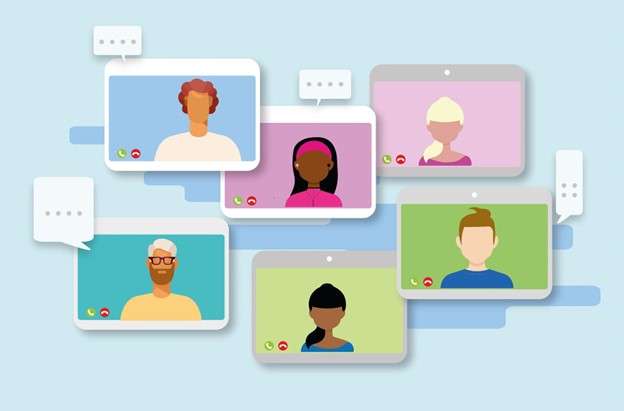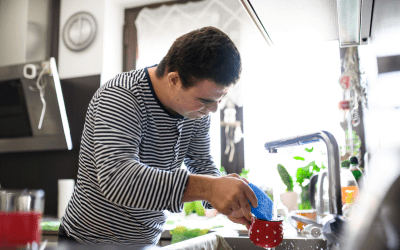…to Elevate Support for People with Disabilities
The Direct Support Professional (DSP) shortage is rising, causing many families unnecessary hardship and financial burden. According to Ancor, in 2022, 83% of providers turn away new people who need services, an increase of 25.8% from the previous year. This leaves over 700,000 families and people with intellectual and developmental disabilities (I/DD) on a waitlist, unable to get needed services. This means many families and natural supports may struggle to balance a job or finances with caring for someone with disabilities.
State and government organizations are developing new and creative ways to address the increasing demand for care providers for developmentally disabled adults. The answer may surprise you.
This article will explore how Remote Supports like SafeinHome can be used with Traditional Provider agencies to enhance a person’s care and relieve the financial burden of natural supports, such as family members. This article will also explore how Remote Supports can help state organizations more effectively address the needs of the people they serve.
Let’s start.
How Remote Supports and Traditional Providers Intersect?
Remote Supports and traditional providers intersect in many ways and can benefit each other. Some of these ways include:
-
A partnered approach
-
Enhanced reach
-
Staff Optimization

A Partnered Approach
A partnered support approach means that DSP agencies work in partnership with Remote Supports to address the shortage of DSPs and to help cover gaps in service. This can provide people in need of service the type of support and outcomes they want. This also assists in placing in-home support workers where they can help the people who critically require their support.
DSP agencies can integrate Remote Support technologies to cover specified shifts, such as overnight or morning shifts, or even all-day support. These technologies can take the form of sensors, audio/visual tablets, and more. Best of all, it’s not just technology, Remote Supports staff are available whenever the individual needs them.
Remote Supports may provide support for people with disabilities for a partial shift, like overnight or having Remote Supports as their primary support with a traditional provider acting as backup in case of emergency.
One approach enables the person to choose where and when they want DSPs and remote support services. In this way, they can utilize Remote Supports’ Geocomm service to avoid getting lost. This allows them the flexibility to choose how their service looks based on their needs and desires. This also allows the DSP to care for another individual who may need it.
Another example includes having a DSP worker take a day shift with the person receiving services. Remote Supports could cover the overnight shift. If the person needs help, they could simply call Remote Supports on their tablet to reach a highly-trained staff member. Not only does this allow the person receiving services more privacy at night, but it also assures the case manager and natural supports that the person receiving services is safer and is being cared for.
Enhanced Reach
Remote Supports can offer clients more freedom through an enhanced service. People with I/DD can receive more person-centered services where their needs and desires are met. This includes services like living independently without traditional providers physically in their homes.
Remote Supports has the ability to give people with I/DD more privacy and individual freedom.

People accepting services can enjoy all these benefits and support at the touch of a button.
Remote Supports also provides data on repetitive patterns. These patterns may help identify issues that allow for adjustments in the care plan. These adjustments can help to better support people with I/DD.
The use of integrating Remote Supports means there is a coordinated approach to delivering care to more people needing services. This means the DSP provider is now more available to take on more clients in their roster. This also means fewer people needing services will be turned away.
Staff Optimization
Most importantly, Remote Supports is a way to optimize resources. Although it cannot replace DSPs, it can reduce the waitlist for services. For some individuals, Remote Supports is a way to have more privacy and individual freedom.
Currently, many providers are turning away new referrals due to a staffing shortage. If more providers used Remote Supports, they could accept more clients. This reduces the bottleneck that many agencies and organizations are experiencing.
Examples of Optimization of Resources
An example of optimization of resources includes optimizing the hours a DSP has for clients who need it more. Some of these clients may be very compatible with receiving support from Remote Supports, allowing the DSP to go where they are most needed. The support need is critical, as seen from Ancor’s statistics. An expanse of resources allows for balance, allowing staff personnel to get needed time off so they don’t burn out. This is necessary, as burnout causes a great deal of turnover in this industry.
This also allows more clients to get off the waitlist and start receiving services, relieving the burden on natural supports much sooner. This makes the lives of everyone involved much easier.
Conclusion
Traditional providers are in high demand and will stay that way for the foreseeable future.
However, organizations are becoming more creative to better serve the people who depend on them. This includes considering Remote Supports like SafeinHome to enhance the services offered to people with disabilities. SafeinHome provides the tools and expert staff needed to increase the independence and freedom of people with I/DD. SafeinHome also bridges the gap between the DSP shortage and people who need services by helping optimize resources and working alongside DSP agencies.

DSPs and people with I/DD stand a lot to gain from Remote Supports. The coordinated effort from Remote Supports like SafeinHome, combined with DSPs, helps ensure the desires of those needing services are met.




